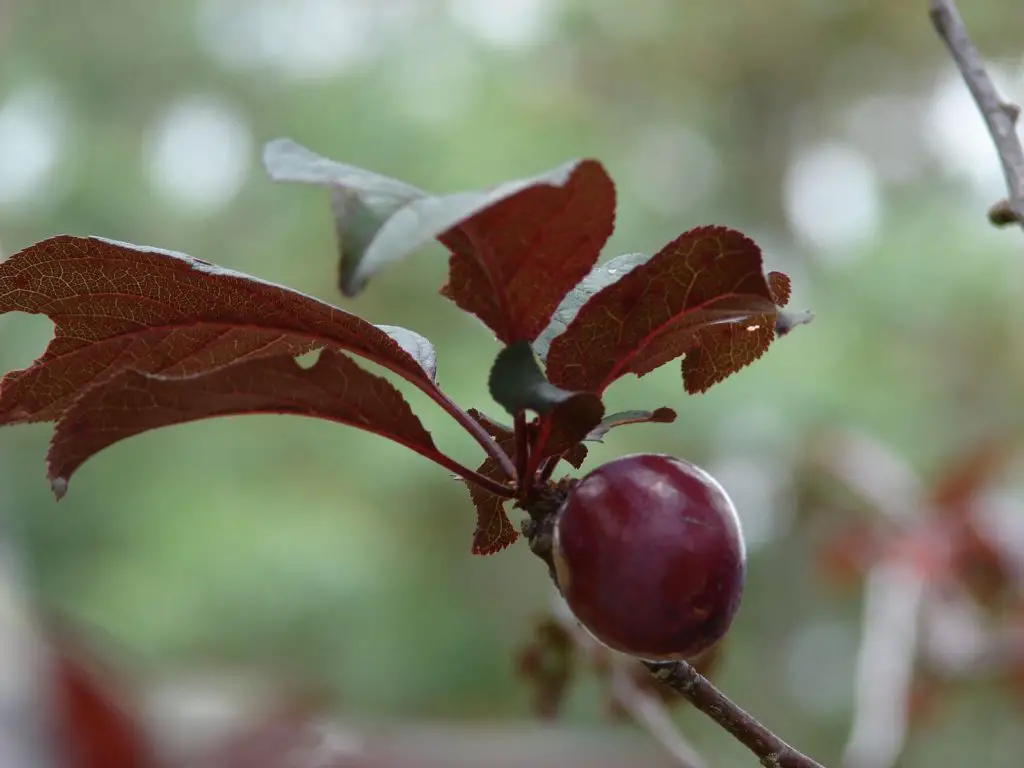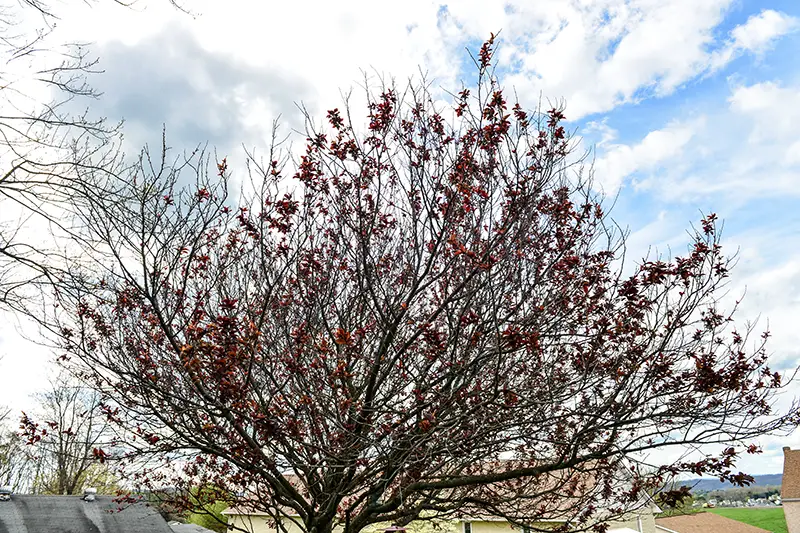Purple Leaf Plum Tree Problems
Jump To:

The purple-leaf plum tree, also known as cherry plum trees or flowering plumb trees, adds interest to your garden or yard with its dark red to purple leaves and abundant white to light pink blossoms. The medium-sized deciduous purple-leaf plum is primarily used as an ornamental tree. Check out the plant care guide on different plants and types of plants for your home.
Zones:
Zones 4-9 are the most common, with most varieties performing best in zones 5-8.
Mature Size
25′ high and 25″ across
Growth Rate
Medium, approximately a foot to two feet per year
Exposure:
Purple-leaf plum trees need to be in full sun or partial shade for best foliage color and blooming. Shade will cause leaves to turn almost completely green and they will not achieve their full richness.
Water:
Regular watering is necessary for purple-leaf plums. Once established, they are fairly drought-resistant but may require additional watering during summer heat.
Pruning:
Other than to remove diseased or dead branches, little pruning is necessary. This should be done after flowering. If silver leaf is an issue, prune in the middle of summer.
Problems, Diseases, Pests:
The purple-leaf plum tree is susceptible to many diseases, including leaf spot, leaf curl, powdery Mildew, fireblight, and leaf spot. They are also vulnerable to pests like borers, Aphids and scale. They can also be susceptible to pests such as borers, aphids, and spider mites. Their short lifespan of less than 20 years is due to these threats. The large number of small fruits produced can make fruit drop a problem. These issues can be a problem if you are concerned. A good alternative is the Eastern redbud with deep violet foliage.
Is Purple Leaf PLUM INVASIVE?
Prunus Cerasifera is invasive in certain areas of the country. Even if you take care to clean up after the fruit has fallen, birds can spread the fruit by carrying the fruit away and dropping the seeds. Rats, raccoons, foxes and opposums do the same thing.
Consider changing your tree if you live in one these areas.
- California: There are many counties in the Bay Area and along the Central Coast.
- Pacific Northwest: The Counties around Seattle, Portland, and Boise as well as many other counties in Idaho and Washington
- Eastern Seaboard: Some Counties in Maine, Massachusetts and New Jersey. New York.
- Other states There are very few counties in Michigan and Montana, Ohio, Pennsylvania or Tennessee.
Is Purple Leaf Plum Fruit EDIBLE?

Purple-leaf plum trees are a precursor to cherry and domestic plum trees. They were named after their fruits long before modern edibles were developed. Prunus Cerasifera is now considered ornamental because they produce domestic plums and cherries. However, many people still enjoy the fruits they produce. Harvesting the small, dark fruits can be difficult because they are surrounded by dark purple foliage. Although both trees have small, light pink blooms in spring, the purple-leaf plum tree can be distinguished by its deep red and purple leaves and their fruits.
Why is my purple plum tree dying?
A dying or diseased plum tree can be caused by bugs or pests, rain, mildew, bacteria, hot and cold weather, frost, no pollination, too much water, or a lack of water. Plum trees are resilient trees and there are many ways to treat bugs and diseases.
How do you take care of a purple leaf plum tree?
Purpleleaf PlumPrunus cerasifera The Purpleleaf Plum should be grown in full sun on well-drained, acid soil to bring out the richest leaf color. It tolerates slightly alkaline soil. Tolerant of moderate heat and drought, it often succumbs to borers on poor, compacted soil.
What’s wrong with my plum tree?
Plums can be prone to diseases such as bacterial canker, honey fungus, blossom wilt, brown rot, silver leaf, plum rust and pocket plum. Potential pest problems include plum moth, aphids, winter moth caterpillar. The fruit fly – spotted wing drosophila (SWD) is likely to become an increasing problem.
How long does a purple leaf plum tree live?
20 years. Even if you offer the best care to your trees, they will prove short lived. Purple leaf plum trees rarely have a lifespan longer than 20 years. You can select from a number of cultivars if you are seeking a particular effect. ‘Atropurpurea’ was developed in 1880, offering reddish-purple foliage and light pink blooms.
What is killing my ornamental plum tree?
Ornamental plums in Southern California have been killed by a bacterium (Xylella fastidiosa) that grows inside a plant’s water-conducting tissue and plugs it up. The bacteria are spread from infected trees to healthy ones by an insect, the glassy winged sharpshooter. Once a tree is infected, there is no cure.
What is killing my plum tree?
Armillaria Root Rot (Armillaria mellea) Armillaria root rot is commonly known as oak root fungus and is ultimately fatal to infected frees. The soil-borne fungus infects the root and crown of the plum tree, and by the time you can see above-ground symptoms, it is likely too late to save the tree.

Do purple leaf plum trees grow fast?
The purple leaf plum tree (Prunus cerasifera), also known as the cherry plum, is popular in landscaping due to its ornamental nature. … This tree has a moderate growth rate and gains about 1 to 2 feet per year. It’s best planted in the early spring or fall.
How do you fertilize a purple plum tree?
Purple leaf plum trees tolerate some drought, although they’ll grow better with regular watering. Water them every two to three weeks during dry, hot conditions. Fertilize purple leaf plum trees in spring with 1/2 cup of 12-6-6 fertilizer if growth is slow.
Do purple leaf Plum trees lose their leaves?
Purple Leaf Hardiness Throughout its hardiness zones, purple leaf plum drops its leaves in fall and needs no extra protection against winter lows. But at the mild end of its growing zones, unexpected highs and lows can warrant stepping in to save the clusters of 1-inch blossoms that appear before purple leaves unfurl.
How do you know when a plum tree is dying?
Initial telltale signs may show first in their leaves before their branches die. Leaves may be slower than usual to emerge in spring and they may turn pale green or yellow. Leaf margins and tips may scorch, which makes them turn brown and drop prematurely.
How do you take care of a sick plum tree?
Plum Pox Virus Once a tree is infected, there is no treatment and the tree should be removed to prevent further infections to nearby plants. Symptoms include discolored rings on leaves and fruits. Controlling aphids is helpful too.
What is the best fungicide for plum trees?
Effective fungicides include fosetyl-al, which is applied to the leaves every 60 days, and mefenoxam, which can be applied in the early spring and fall. However, the best thing to do is prevent these fungal diseases by not overwatering and choosing a site with well-drained soil.
Are purple leaf plum trees messy?
Purple Leaf Plum Care. In terms of its care, plan to water your tree throughout the growing season, April through October, without sufficient rainfall. This tree also benefits from regular feeding and pruning. It can be a messy tree if fruit forms in spring.
How often should a plum tree be watered?
Give your tree enough water to soak the ground all around the roots. It’s important to note that even if you’re in the midst of a brown-lawn drought, you don’t want to water too much. Once every 10 days or two weeks is plenty. Worse than dry, thirsty roots is waterlogged, drowning roots.
Why are the leaves on my purple plum tree turning green?
The leaves will turn from purple to green if your tree gets too much shade. Holes in the leaves are not unusual – many types of beetles will feed on the leaves and then move on to other plants in other yards. … You can help your tree fill out by pruning it lightly after the flowers fade each spring.
How do I get rid of fungus on my plum tree?
Prune out all infected branches in late winter (late February through the end of March) and destroy them by burning, burying, or throwing them away. Remove at least 3-4 inches of healthy tissue below each knot to ensure elimination of the fungus.
Why do my plums rot on the tree?
Brown rot is a fungal disease of apples, pears, plums, cherries and some other fruit and ornamental trees, causing a brown, spreading rot in fruit. It is caused by the same fungi that cause blossom wilt of the flowers and fruit spurs.
What is the life expectancy of a plum tree?
10 to 15 years The average lifespan for cultivated plum trees is 10 to 15 years, according to the Lady Bird Johnson Wildflower Center’s website.
What should I spray on my plum trees?
Once the fruit begins to develop and the husks are pulling back from the fruit, spray plums with spinosad, esfenvalerate, or permethrin to control the twig borers. Spray again with a mix of fungicide, malathion, and sulfur to control leaf curl, plum pocket, scab, and brown rot, and aphids.
How long does it take for a plum tree to bear fruit?
three to six years Plum trees begin to bear when they are three to six years of age. You can tell right after bloom if your tree will set fruit.
How much water does a purple leaf plum tree need?
Most purple leaf plums grow to cover a 20 by 20 foot area. This translates to a fully grown plum requiring more than 50 gallons of water on a 100 F, windy summer day or as little as 18 to 20 gallons in the cool of the early spring or fall.
Are purple plum trees invasive?
While these trees are bred not to bear fruit, they may, in fact, produce a small amount of fruit anyway. When deciding which ornamental plum tree to plant in your yard, consider that most species of ornamental plum trees are classified as “limited invasive,” except Blireiana flowering plum (Prunus blireiana).
Can you use Miracle Grow on fruit trees?
Miracle-Gro has tree spikes specially formulated for trees, shrubs, evergreens, fruit, citrus, and palm trees. They should be used annually, in the spring and early fall, for a continuous release of nutrients. These easy-to-use spikes provide nutrition directly to the roots, where plants need it most.
Is Epsom salt good for plum trees?
Fruit trees like citrus, apples, peaches, pomegranate, and plums perk up after application of Epsom salt.
When should I fertilize my purple leaf plum tree?
Fertilize the purple leaf plum every spring before new growth appears with a general-purpose fertilizer. Check the tree regularly for pests, such as aphids, scales, borers, mealy bugs and tent caterpillars.
Do plum trees need a lot of water?
Just as important as feeding your plum tree, it’s equally important to provide adequate water. Young plum trees need to be watered at least once a week to promote healthy root growth. Once the tree is established, it requires regular watering, especially in the dry summer months.
Why does my plum tree have no leaves?
A tree with no leaves can be attributed to bud issues. If there are many buds dead, but the branch is alive, then the tree has been suffering for some time. The problem could be due to stress or a root problem. Suspect disease when there are no buds at all.
How do you prune a purple leaf plum tree?
Examine your purple leaf plum tree for dead, diseased or damaged branches. … Remove downward-growing branches. … Cut off branches that rub against other branches. … Pinch off the growing tips of new buds to encourage lateral branching and continued growth of your purple leaf plum.
How do you revive a dying fruit tree?
How to Save a Dying Tree: 5 Easy Steps to Success Identify the Problem. Before you can effectively figure out how to save a dying tree, it is important to try to determine the problem. … Correct Watering Issues. … Be Careful with Mulch. … Use Fertilizer Properly. … Prune Properly.
How do you keep a plum tree healthy?
How to Care for Plum Trees Be sure to water the young trees heavily every week during the first growing season to help promote growth. Then, water regularly. … If rain is lacking, water your tree well into mid-October to give it plenty of moisture through the winter months.
How do you make homemade fungicide spray?
Mixing baking soda with water, about 4 teaspoons or 1 heaping tablespoon (20 mL) to 1 gallon (4 L.) of water (Note: many resources recommend using potassium bicarbonate as a substitute for baking soda.). Dishwashing soap, without degreaser or bleach, is a popular ingredient for homemade plant fungicide.
Is Captan a fungicide?
Captan is a man-made fungicide used to control a range of fungal diseases on plants. It is commonly used on both edible crops and ornamental plants. Captan affects a fungus by interrupting a key process in its life cycle. If consumed, it is very low in toxicity but it can be harmful to eyes.
What can I use for fruit tree fungus?
Do plum trees have invasive roots?
A plum tree does not have a notorious root system, one that heaves up sidewalks, for instance. These feeder roots extend horizontally to the edge of the leaf canopy, or drip line, and beyond up to 1 1/2 times the height of the tree. A few anchoring “sinker” roots grow down several feet to stabilize the tree.
Are purple plum trees poisonous to dogs?
What is Plum Poisoning? Plums are grown on large shrubs or small trees with pretty white flowers similar to apple blossoms. Plums are one of several fruits that contain hydrogen cyanide, which is extremely toxic to dogs if eaten.
How long does a thundercloud plum tree live?
The lifespan of this tree is comparatively short, as It generally lives up to 20 years on an average. It can reach a height of 25 feet, however, many of them are found in the range between 15 to 25 feet.
How do you treat a canker on a plum tree?
For canker on plums and cherries, treat with a copper fungicide (containing copper oxychloride) 3 times a year: mid-August, mid-September and mid-October. Copper fungicides are also useful controls for peach leaf curl.
Are purple leaf plum trees deciduous?
Purple-leaf plum trees, also called cherry plum trees or flowering plum trees, can add interest to your yard or garden with their dark red to purple foliage and abundance of white to light pink spring blossoms. Purple-leaf plums are medium-sized, deciduous trees primarily used for ornamental purposes.
